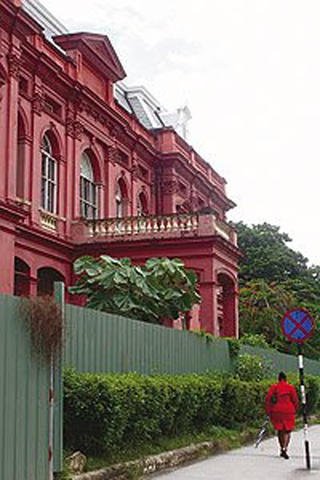(Trinidad Guardian) Government will pump TT$400 million into restoration work on the controversial Red House project by the end of March.
The Urban Development Corporation of T&T (Udecott) has already spent TT$110 million on consultancy and construction work on the historical building, which remains unfinished.
Work on the Red House began 19 years ago, with Udecott assuming responsibility for the project in 2005.
To bring the project to a close, Udecott will inject a further TT$381 million on construction of a Parliamentary Complex—phase two—taking the total figure for the iconic building to a whopping $891 million.
Confirmation came from chairman of Udecott Noel Garcia at his Sackville Street, Port-of-Spain, office on Monday.
Sitting in the company of Udecott’s chief operations officer Abena Richards, Garcia revealed that public tenders for the restoration project went out last June.
Of the ten companies that submitted bids, Garcia said only three had pre-qualified.
“Those tenders have been evaluated. A decision is to be made before the end of the week as to how we are to proceed.
“A recommendation will come to the board on Wednesday. I expect we will have to sit and negotiate with the preferred contractor. This has to go to Cabinet for approval. We are talking about another two months. I suspect restoration work will start on the Red House by the end of March,” Garcia disclosed.
Garcia estimated the cost of the project at “TT$340 million to TT$400 million,” to be completed in 2018.
Since 1997, Garcia said, the Red House was earmarked to be restored, but this had been hindered by delays.
Once completed, Garcia said, Udecott would move to construction of the Parliamentary Complex on the northern side of the Red House to house administrative staff, a library, offices for MPs and other staff.
Richards said the complex’s “current base building cost” exclusive of outfitting costs and Value Added Tax (VAT) is estimated at TT$346.1 million “without contingency.”
With contingency-exclusive of VAT, Richards estimated the cost at TT$381.1 million.
Richards disclosed that the design work for the Parliamentary Complex “was ongoing right now. Once that is complete then we will go out for tender and then construction.”
Richards also gave a breakdown of the ten companies which were paid “thus far” by Udecott for consultancy and construction work on the Red House, which amounted to TT$110 million exclusive of VAT.
The largest payment went to Canadian firm Genivar Ltd who collected TT$26.7 million. Genivar was contracted to renovate and refurbish the southern and mid-section of the Red House, which was expected to house the Office of the Prime Minister.
The next biggest payment went to Bernard Mackay Architect/Saraiva e Associados, SA Joint Venture, with TT$23.4 million.
Enco Ltd was paid the least with TT$1.6 million.
Garcia: Project faced with
administrative confusion
Garcia said that given the technical nature of the “plaster of paris” works to be undertaken on the ceiling of the Red House, masonry and ironmongery skills would be required.
“So whoever gets the restoration contract must have technical assistance from foreign firms,” Garcia said.
Asked what delayed work on the historical building, Garcia said: “There were a number of issues.”
Among them were administrative changes, budgetary constraints, and changes in the scope of works.
Another setback occurred in 2014, following the discovery of bones and cultural artefacts during an excavation phase at the Red House, Garcia said.
“To a certain extent there was a bit of administrative confusion or ambiguity as to what should have been done. Then there were technical issues and hurdles. Restoration requires specialists. It was not a case of simply going out there to restore it. You have to get people who can understand what needs to be done. Then you have to reduce it into a brief and then tender. So those were factors that delayed the project,” Garcia said.
 He said whenever a new administration came into power the project changed direction.
He said whenever a new administration came into power the project changed direction.
Garcia said when then prime minister Patrick Manning was in power there were plans to move the prime minister’s office to the Red House.
“That plan fell through the cracks when the Kamla Persad-Bissessar-led government came into office in 2010, which saw the Red House being relocated to the Waterfront (International Financial Centre, Tower D). It took a different turn.
“There was a lot of to-ing and fro-ing,” said Garcia.
“It has been a long time. It became almost like a football. It started with Nipdec then it went to the Ministry of Works. After that it was in abeyance. Then it landed in Udecott’s hands,” Garcia said.
Yesterday, in response to a text message, former leader of government business Dr Roodal Moonilal said to his knowledge the then People’s Partnership government did not pay Udecott—the landlord—a rent when the Red House shifted from Port-of-Spain to the Waterfront in 2011 “since it was a government building not private owners.”







